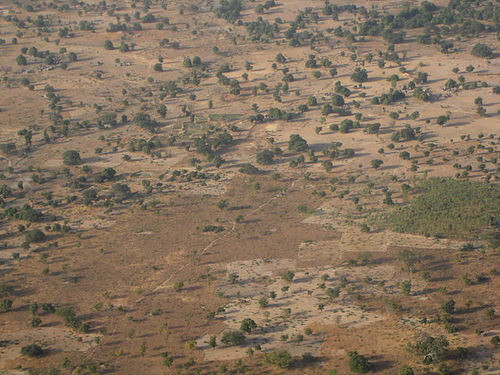m (→Interwiki links: category) |
(biodiversity) |
||
| Line 1: | Line 1: | ||
[[File:640px-Savannaburkina.jpg|right|500px]] | [[File:640px-Savannaburkina.jpg|right|500px]] | ||
== Initiatives by topic == | == Initiatives by topic == | ||
=== Biodiversity === | |||
Burkina Faso is largely wild bush country with a mixture of grass and small trees in varying proportions. The savanna region is mainly grassland in the rainy season and semi desert during the harmattan period (defined as the period when stormy and dusty Sahara winds blow dry and hot). Fauna, one of the most diverse in West Africa, includes the elephant, hippopotamus, buffalo, monkey, lions, crocodile, giraffe, various types of antelope, and a vast variety of bird and insect life. | |||
To ensure conservation and preservation of the wildlife of Burkina Faso, four national parks have been established. These are the Po National Park in the south-centre of the country, Arli National Park established in 1954 in the southeast, W of the Niger National Park, a trans frontier park existing since 1957 in the east bordering [[Benin]] and [[Niger]] and the Deux Balés National Park. The forests, fauna and fish have been declared part of the national estate of Burkina Faso. In addition, the List of national parks of Burkina Faso consist of one UNESCO Biosphere reserve, three Complete Reserves, six Partial Reserves and ten protected forests. However, according to conservation classification conducted between 1936 and 1957, the country has 78 protected areas that cover 38,369 km2 (14,814 sq mi), which accounts to about 14% of the area of the country. {{W|Wildlife of Burkina Faso}} | |||
=== Food activism === | === Food activism === | ||
Revision as of 11:39, 8 February 2016

Initiatives by topic
Biodiversity
Burkina Faso is largely wild bush country with a mixture of grass and small trees in varying proportions. The savanna region is mainly grassland in the rainy season and semi desert during the harmattan period (defined as the period when stormy and dusty Sahara winds blow dry and hot). Fauna, one of the most diverse in West Africa, includes the elephant, hippopotamus, buffalo, monkey, lions, crocodile, giraffe, various types of antelope, and a vast variety of bird and insect life.
To ensure conservation and preservation of the wildlife of Burkina Faso, four national parks have been established. These are the Po National Park in the south-centre of the country, Arli National Park established in 1954 in the southeast, W of the Niger National Park, a trans frontier park existing since 1957 in the east bordering Benin and Niger and the Deux Balés National Park. The forests, fauna and fish have been declared part of the national estate of Burkina Faso. In addition, the List of national parks of Burkina Faso consist of one UNESCO Biosphere reserve, three Complete Reserves, six Partial Reserves and ten protected forests. However, according to conservation classification conducted between 1936 and 1957, the country has 78 protected areas that cover 38,369 km2 (14,814 sq mi), which accounts to about 14% of the area of the country. W
Food activism
Solar cooking resources in Burkina Faso
News and comment
2010
2010 SEED Award Winners, [1] November 3
"Manufacture and Popularization of Biomass Briquettes". Aiming to replace wood and charcoal with biomass briquettes from fallen leaves and other sources of unused biomass, this progressive enterprise of local and international NGOs and a research institution helps to combat desertification, create jobs in rural communities and raise awareness for alternative energy sources.
"Initiative for Promoting and Distributing Bio-Pesticides". The initiative's ambitious goal is to promote and distribute ecological pest control for organic crops, especially cotton, vegetable and oil-producing crops. In this way, the partnership of local and community-based organisations and research agencies hopes to increase yields and preserve the production environment.
2009
2009 SEED Award Winners, [2] May 12
"Nafore & Afrisolar energy kiosks". A small business and international NGOs are cooperating to provide sustainable energy supply to poor communities by expanding the use of "Nafore", a PV-based telephone charger, powered 100% on solar energy.
Interwiki links
Wikipedia: Burkina Faso, Yacouba Sawadogo
References Template:Attrib sca ref